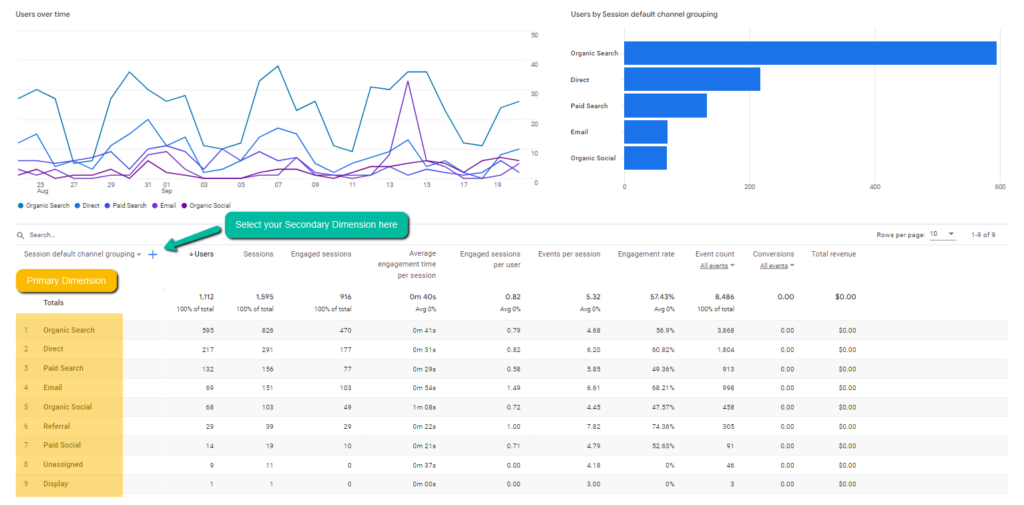Comprehensive Insights Utilizing Secondary Dimension in Google Analytics
Unlock Deeper Insights With Secondary Measurement in Google Analytics
With the vast area of information offered in Google Analytics, the usage of secondary dimensions can considerably enhance your logical capabilities. By tactically integrating secondary measurements into your evaluation, you can unearth beneficial understandings that may or else stay undiscovered - Secondary Dimension in Google Analytics.
Understanding Primary Vs. Secondary Measurements
When examining data in Google Analytics, it is important to compare primary and second measurements to get much deeper insights right into individual behavior. Primary measurements are the major groups through which you can view your information, such as source/medium, landing, or device web page. These measurements offer the fundamental framework for organizing and recognizing your data. On the other hand, additional dimensions permit you to further dissect your primary dimension information. By including a second dimension, you can layer on added details to your primary measurement, allowing a much more granular evaluation. If your key dimension is the source/medium through which users got here on your site, including an additional dimension like geographical place can expose where those users are located geographically. When looking at the main dimension alone, this added layer of information can help you identify patterns, patterns, or anomalies that might not have been noticeable. Leveraging both additional and key dimensions in Google Analytics is critical for detailed data evaluation and informed decision-making.
Utilizing Second Dimensions Properly
Effectively making use of additional measurements in Google Analytics boosts the depth and granularity of information evaluation, offering useful understandings into customer actions and patterns. By including second dimensions together with main measurements, experts and online marketers can dig much deeper into the specifics of user interactions on their web sites. Additional dimensions enable customers to segment and filter primary measurement data additionally, using a much more in-depth sight of user communications, actions, and demographics. This can be specifically valuable when attempting to understand the effect of details variables on customer engagement, such as the gadgets or internet browsers they are using, the resources of their website traffic, or their geographical places.
In addition, second dimensions enable users to compare and contrast various data factors within a solitary report, promoting an extra detailed analysis of customer behavior patterns. By leveraging secondary dimensions effectively, services can discover surprise insights, maximize their advertising and marketing techniques, and improve the total customer experience on their sites.
Checking Out Usual Additional Measurement Combinations
To better evaluate customer behavior and fads in Google Analytics, it is important to explore common mixes of second measurements. Some typical additional measurement combinations that give beneficial insights include evaluating website traffic resources with customer locations to understand where site visitors are coming from geographically and just how they found the website. Examining individual actions metrics with secondary measurements such as passions or demographics can help in targeting details audience sectors much more properly.
Using Second Dimension in Customized Information
Making use of second dimensions in personalized reports permits an extra thorough evaluation of data in Google Analytics, improving the deepness of insights acquired. When producing custom-made records in Google Analytics, including second dimensions can provide a more in-depth sight of how various dimensions connect with each various other. This feature enables individuals to delve much deeper into their information and discover useful relationships that might not be promptly apparent.
By applying second dimensions navigate to this site in custom-made reports, users can get a much better understanding of their website or app traffic. Combining the key measurement of "source/medium" with the additional dimension of "landing page" can reveal which touchdown web pages are performing ideal for web traffic coming from particular sources. This understanding can help marketing professionals optimize their projects and enhance overall conversion rates.

Enhancing Data Visualization With Additional Dimension
When checking out data in Google Analytics customized reports, including secondary measurements not only supplies an extra detailed analysis however also enhances the graph of understandings through information visualization. By including a secondary measurement to your records, you can improve the method information is offered, making it less complicated to determine patterns, fads, and relationships within your internet site's efficiency metrics.
Additional dimensions can help you sector your data further, permitting for a much deeper understanding of customer behavior and interactions on your website. This enhanced level of granularity can be specifically helpful when attempting to separate certain variables that may impact your site's performance - Secondary Dimension in Google Analytics.

Conclusion
Finally, leveraging additional measurements in Google Analytics enables a much more extensive analysis of data, bring about much deeper insights and even more informed decision-making. Secondary Dimension in Google Analytics. By including additional layers of information to main information sets, marketing experts and experts can uncover hidden fads, patterns, and connections that offer a granular view of individual behavior and communications. This enhanced degree of insight makes it possible for optimization of projects and tailored approaches for details audience segments, ultimately boosting performance and conversion rates
On the various other hand, secondary dimensions permit you to more explore your key dimension information. By adding an additional dimension, you can layer on additional info to your primary dimension, allowing an extra granular analysis. If your primary measurement is the source/medium with which customers got here on your site, including a second dimension like geographic place can disclose where those users are located geographically. By incorporating second measurements along with primary dimensions, experts and marketers can delve much deeper right into the specifics of individual communications on their websites. Secondary dimensions allow users to section and filter main measurement information further, using a more detailed sight of customer communications, habits, and demographics.